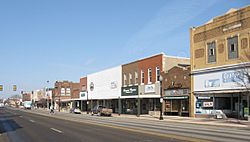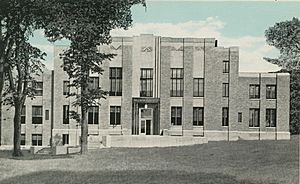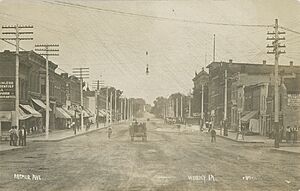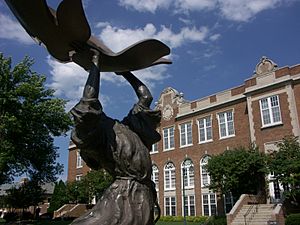Waverly, Iowa facts for kids
Quick facts for kids
Waverly, Iowa
|
|
|---|---|

Waverly, Iowa
|
|

Location of Waverly, Iowa
|
|
| Country | |
| State | |
| County | Bremer |
| Area | |
| • Total | 11.76 sq mi (30.46 km2) |
| • Land | 11.26 sq mi (29.16 km2) |
| • Water | 0.50 sq mi (1.30 km2) |
| Elevation | 912 ft (278 m) |
| Population
(2020)
|
|
| • Total | 10,394 |
| • Density | 923.09/sq mi (356.39/km2) |
| Time zone | UTC-6 (Central (CST)) |
| • Summer (DST) | UTC-5 (CDT) |
| ZIP code |
50677
|
| Area code(s) | 319 |
| FIPS code | 19-82875 |
| GNIS feature ID | 0462757 |
Waverly is a city in Bremer County, Iowa, United States. It is the main city of Bremer County. In 2020, about 10,394 people lived there. Waverly is part of the larger Waterloo–Cedar Falls area.
Waverly has a special connection with Eisenach, a city in Germany. Eisenach is famous for its Wartburg castle. Waverly is home to Wartburg College, which is named after this famous castle.
Contents
Discover Waverly's History
Native American History in Waverly
The first people to live in the Waverly area were the Winnebago tribe. They were forced to move here in the 1830s. This happened after the Blackhawk War of 1832. The Winnebago were moved to a place called Neutral Ground in what is now Iowa.
Other tribes like the Meskwaki and Pottawattomi also lived nearby. But after Iowa became a state in 1846, the Winnebago were forced to move again. They were moved five times between 1840 and 1863. This constant moving caused many tribal members to lose their lives. Finally, in 1865, the Winnebago Reservation in Nebraska was created.
How Waverly Was Settled and Named
The first European settler in Waverly was Frederick Cretzmeyer. He bought land in 1852 and built a log cabin. Soon, more settlers arrived and built homes.
William Patterson Harmon came to Waverly in 1853. He wanted to start a town and a saw mill. He bought most of the land that is now Waverly for a very low price. The area officially became a town on April 25, 1859.
There are two stories about how Waverly got its name. One story says that a speaker at a ceremony was a big fan of Sir Walter Scott's Waverley novels. He accidentally called the town "Waverly" instead of "Harmonville," which was the proposed name. Another story says William Harmon's daughter wrote that her father chose the name after his favorite book.
Even the county, Bremer County, is named after a writer. It was named in 1850 after Fredrika Bremer, a Swedish author.
Early Buildings and Landmarks
The first school in Waverly opened in a log cabin in 1854. A stone school house was built by 1855. The first students graduated from Waverly High School in 1875. Wartburg College moved to Waverly in 1856. The public library was started in 1866.
In 2014, a part of Waverly called the Waverly East Bremer Avenue Commercial Historic District became a historic place. This area includes the old post office, which has a special painting inside. The painting shows a farm family reading a letter in 1856.
What's Waverly Like?
Waverly's Location
Waverly is located in Iowa. Its exact coordinates are 42.726530 degrees North and -92.475366 degrees West.
The city covers about 11.51 square miles (29.81 square kilometers). Most of this area is land, and a small part is water.
People in Waverly
| Waverly historical population | ||
|---|---|---|
| Year | Pop. | ±% |
| 1870 | 2,291 | — |
| 1880 | 2,345 | +2.4% |
| 1890 | 2,346 | +0.0% |
| 1900 | 3,177 | +35.4% |
| 1910 | 3,205 | +0.9% |
| 1920 | 3,352 | +4.6% |
| 1930 | 3,652 | +8.9% |
| 1940 | 4,156 | +13.8% |
| 1950 | 5,124 | +23.3% |
| 1960 | 6,357 | +24.1% |
| 1970 | 7,205 | +13.3% |
| 1980 | 8,444 | +17.2% |
| 1990 | 8,539 | +1.1% |
| 2000 | 8,968 | +5.0% |
| 2010 | 9,874 | +10.1% |
| 2020 | 10,394 | +5.3% |
| Source: Source: |
||
In 2020, Waverly had 10,394 people living there. This was an increase from 9,874 people in 2010. Most of the people in Waverly are White. About 19.5% of the people are under 18 years old. Many young adults, about 18.4%, are between 18 and 24 years old. This group includes students at Wartburg College.
The average household in Waverly has about 2.34 people. Most adults in Waverly have graduated from high school. Many also have a college degree.
Education in Waverly
Waverly is home to Wartburg College. This is a four-year college that opened in 1852. It is known for its liberal arts programs. In the 2016–2017 school year, about 1,482 students attended Wartburg College.
The Waverly-Shell Rock Community School District runs the public schools in the area. There are four elementary schools, one middle school (grades 5-8), and one high school. The district wants to help students love learning for their whole lives.
St. Paul's Lutheran School is also in Waverly. It teaches students from preschool to sixth grade.
Waverly's Economy
Waverly has several important employers. These include CUNA Mutual Group, Waverly Health Center, Wartburg College, and Nestlé Beverage. The Waverly-Shell Rock Community School District also employs many people. Other major employers are Peoples Insurance Agency and GMT Corporation.
How Waverly Gets Power
Renewable Energy Efforts
Waverly Light & Power Company is a leader in renewable energy. In 1993, they were the first public power system in the Midwest to use wind power. They installed a wind turbine outside the city.
They have a goal called "20 by 20-20." This means they want to get 20% of their energy from renewable sources by the year 2020. Waverly Light & Power has also helped create transformer oil made from soybeans.
Local Radio
Waverly has its own local radio stations. These are KWAY (AM) and KWAY-FM. Their studios and transmitters are located on the south side of Waverly.
Fun Facts About Waverly
Waverly has a high number of ordained Evangelical Lutheran Church in America (ELCA) clergy members. In the 1990s, it was estimated that Waverly had 37 ELCA clergy. This meant there was about one clergy member for every 243 people.
Waverly also has St. John Lutheran Church. This church is part of the Lutheran Church–Missouri Synod.
Famous People from Waverly
- Edward C. Droste, who helped start Hooters restaurants.
- A. J. Hinch (born 1974), a former professional baseball player and manager. He managed the 2017 World Series champion Houston Astros.
- John Sladek (1937–2000), an author who wrote science fiction and mystery books.
- Michael Talbott, an actor known for his role in the TV show Miami Vice.
- Dennis Wagner, a college football coach.
- Clint Barton, a Marvel superhero also known as Hawkeye.
Sister cities
- Sister city since 1992 - Eisenach, Germany
See also
 In Spanish: Waverly (Iowa) para niños
In Spanish: Waverly (Iowa) para niños





